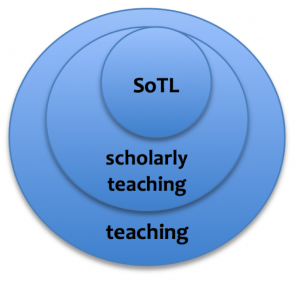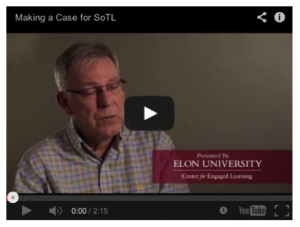Historian David Pace acknowledges the increasing calls for this combination of teaching and research:
“A consensus has formed within growing circles in academia that there is scholarly research to be done on teaching and learning, that the systematic creation of rigorous knowledge about teaching and learning is a crucial prerequisite to responding to major challenges facing academia, that this knowledge must be shared publicly and should build cumulatively over time, and that the explorations of this area should be conducted by academics from all disciplines, not just those with appointments in schools of education” (2004, p. 1174).
The inaugural issue of Teaching & Learning Inquiry, the journal of the International Society for the Scholarship of Teaching and Learning (ISSOTL), features several essays that articulate the reasons for Pace’s “consensus,” including the need for and value of SoTL. Dan Bernstein, for instance, argues that those who participate in SoTL are “assets” to their institutions because they
“generate visible analyses of student learning taking place in their institutions, provide excellent models of practice for local colleagues, generate high-quality evidence for internal and external assessment, and offer accessible examples of quality education to prospective students” (2013, p. 35).
Joëlle Fanghanel explains that SoTL “offers an alternative and more faculty-friendly model of faculty development that replaces the pervasive model based on competition, outputs, performativity, and solitude with one that’s democratic, dialogic, process-focused, and collaborative” (Chick & Poole, 2013, p.3).
Keith Trigwell’s article offers a syllogism that accounts for SoTL’s impact on student learning. Previous studies have shown that certain approaches to teaching lead to deeper learning than other approaches (2013, p. 98). These more effective approaches are highly utilized by those who practice SoTL (p. 99-100). Therefore, practitioners of SoTL are more likely to foster students’ deep learning (pp. 100-101).
The merits of SoTL aren’t limited to those who practice it; its goal of improving teaching and learning points to the broader groups that will benefit from it. SoTL is a specialized kind of research that delves deeply into how students learn within and across the disciplines, so reading it and keeping up with new findings—without conducting actual SoTL studies—are effective ways to maintain a scholarly approach to teaching. Then, as is the case within the disciplines, some scholars will choose SoTL as an area of their research. As Lee. S. Shulman, president emeritus of the Carnegie Foundation for the Advancement of Teaching, explains:
“Scholarly teaching is what every one of us should be engaged in every day that we are in a classroom, in our office with students, tutoring, lecturing, conducting discussions, all the roles we play pedagogically. Our work as teachers should meet the highest scholarly standards of groundedness, of openness, of clarity and complexity. But it is only when we step back and reflect systematically on the teaching we have done, in a form that can be publicly reviewed and built upon by our peers, that we have moved from scholarly teaching to the scholarship of teaching.” (2004, p. 166).
The video below offers some additional perspectives on the value of SoTL.

"Making a Case for SoTL," an online component of the International Society for the Scholarship of Teaching and Learning (ISSOTL) 2013 Conference (c/o Elon University’s Center for Engaged Learning)

